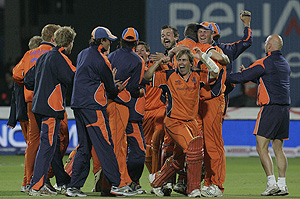
News today that only the 10 Test playing cricket nations will be represented at the 2015 Cricket World Cup in Australia and New Zealand is a knee jerk reaction to criticism about the length of the 2007 and 2011 tournaments, and again shows just how narrow sighted the ICC are.
The decision seems so much like a bad joke that I had to check the date to make sure I was not being sucked in by an April Fool’s Day hoax. It is even more of a joke that it is not such a hoax.
For the record, the following nations are Test playing nations: Australia, New Zealand, England, West Indies, Pakistan, India, South Africa, Sri Lanka, Bangladesh and Zimbabwe.
From the most recent Cricket World Cup, the following nations will miss out: Ireland, Canada, the Netherlands and Kenya.
At the outset, my view is that the failure to include Ireland as a full cricketing nation as well as it not being in the next World Cup is a disgrace. Nothing less. The sooner Ireland is placed on the track to becoming a full cricketing nation, the better.
That said, what should be done about the 2015 World Cup, aside from including Ireland as a full cricketing nation?
I come back to the theme of a previous post. Teams such as Sri Lanka, Bangladesh and Zimbabwe were once (and some would say in the case of the last two teams still are) “minnows” or associate teams.
The story of Sri Lanka’s rise from “minnow” to being one of the powerhouses of the game is a great story and is instructive as to why the ICC’s decision is just so wrong.
Sri Lanka’s initial exposure to international cricket was in the 1975 World Cup (they lost all three games they played). Then they did not play in another international tournament until the 1979 World Cup (where they won their first game against India and had a match abandoned as well as losing one game).
After the 1979 World Cup, Sri Lanka began playing in Test match cricket on a limited basis in the 1981/82 season and played in a limited number of one-day tournaments in the meantime.
In the 1983 and 1987 World Cups, the Sri Lankan team failed to record a victory from 10 games. In 1992 the results of the Sri Lankan team started to improve with two victories and a no result the positives from six games of cricket played.
Before the Sri Lankan team won the 1996 World Cup it had won thre games from a total of 22 played at World Cups. Importantly during this period Sri Lanka was offered and maintained Test status and started playing cricket regularly. There is no need to continue to expand on Sri Lanka’s results since 1992 – they are one of the dominant forces in the game.
Why shouldn’t the current associates be given a chance to emulate what Sri Lanka has done with its chance? If at any point in those formative years up to and including 1992 the ICC (and its predecessors) had have made a decision like the present one, what state would Sri Lankan cricket be in now?
Is it possible that names such as Sangakarra, Malinga et al would have been lost to cricket?
Equally, questions need to be asked as to why Zimbabwe and Bangladesh, as Test playing nations, receive an automatic chance to play in the “big show” when their respective results are no better than, for example, Ireland.
Zimbabwe, the country and the cricketing team, are not worthy of a place in the “top 10” cricketing nations in the world.
The ICC has always gone against public and moral opinion and kept them in the game (albeit with a reduced role) for no cogently explained reason. It can’t be about money, because playing Zimbabwe could not be making anyone any money.
The inclusion of the Bangladesh team presents even more of a conundrum because they have been playing Test cricket regularly but they are not, let’s be honest, competitive. Equally the reasons for Bangladesh’s inclusion in the “top 10” are clear – Bangladesh has a fanatical base of supporter, a large TV market and form part of the all conquering Asian bloc of international cricket. Whether one likes it or not the Bangladesh cricket team is in the “top 10” to stay.
So in the current “top 10” we see two minnows of the game who will be at the next World Cup. Frankly, Zimbabwe do not deserve to be an automatically selected team for the next World Cup by any measure.
Setting aside the problems with the regime in Zimbabwe, the Zimbabwe cricket team is a minnow by any measure and, indeed, has not played a Test match since 2006 and has only been involved in a limited number of limited overs matches in recent years.
It is abundantly clear from this decision that the ICC wishes to limit the number of teams at the next World Cup to 10 teams.
If 10 teams is the maximum (I for one do not believe that 12 teams would be out of the question, but will focus on the 10 team scenario for the moment) then the answer must be for their to be a qualifying tournament before the World Cup to be held with each of the associates, including Zimbabwe, Ireland and the Netherlands playing off for the final spot in the “top 10”.
Any tournament that includes a team of Zimbabwe without at the very minimum allowing teams like Ireland and the Netherlands to compete with it for the last spot in the tournament is, simply, a joke and the sooner the ICC reconsiders this ridiculous decision the better.






























































































